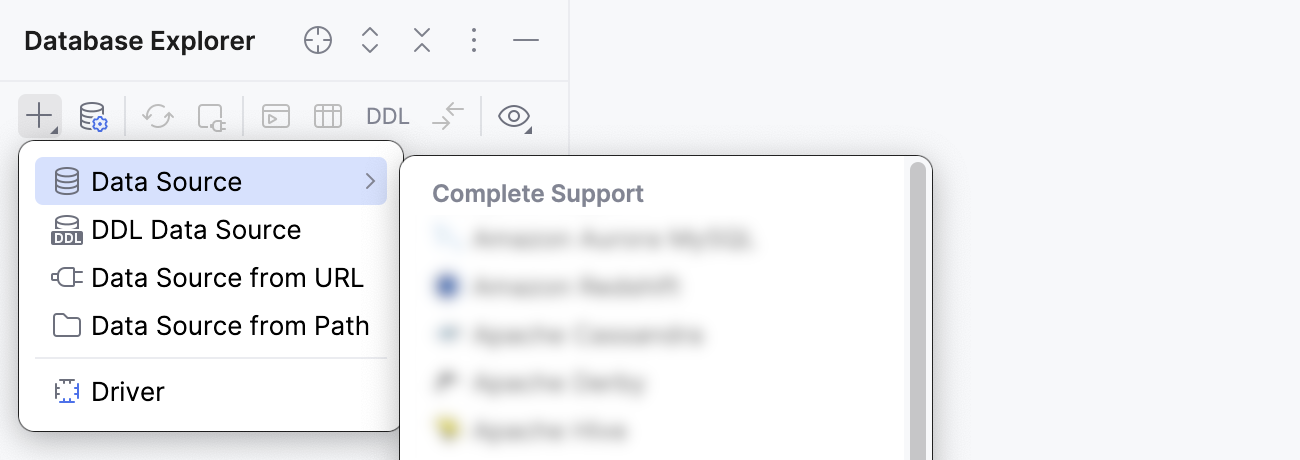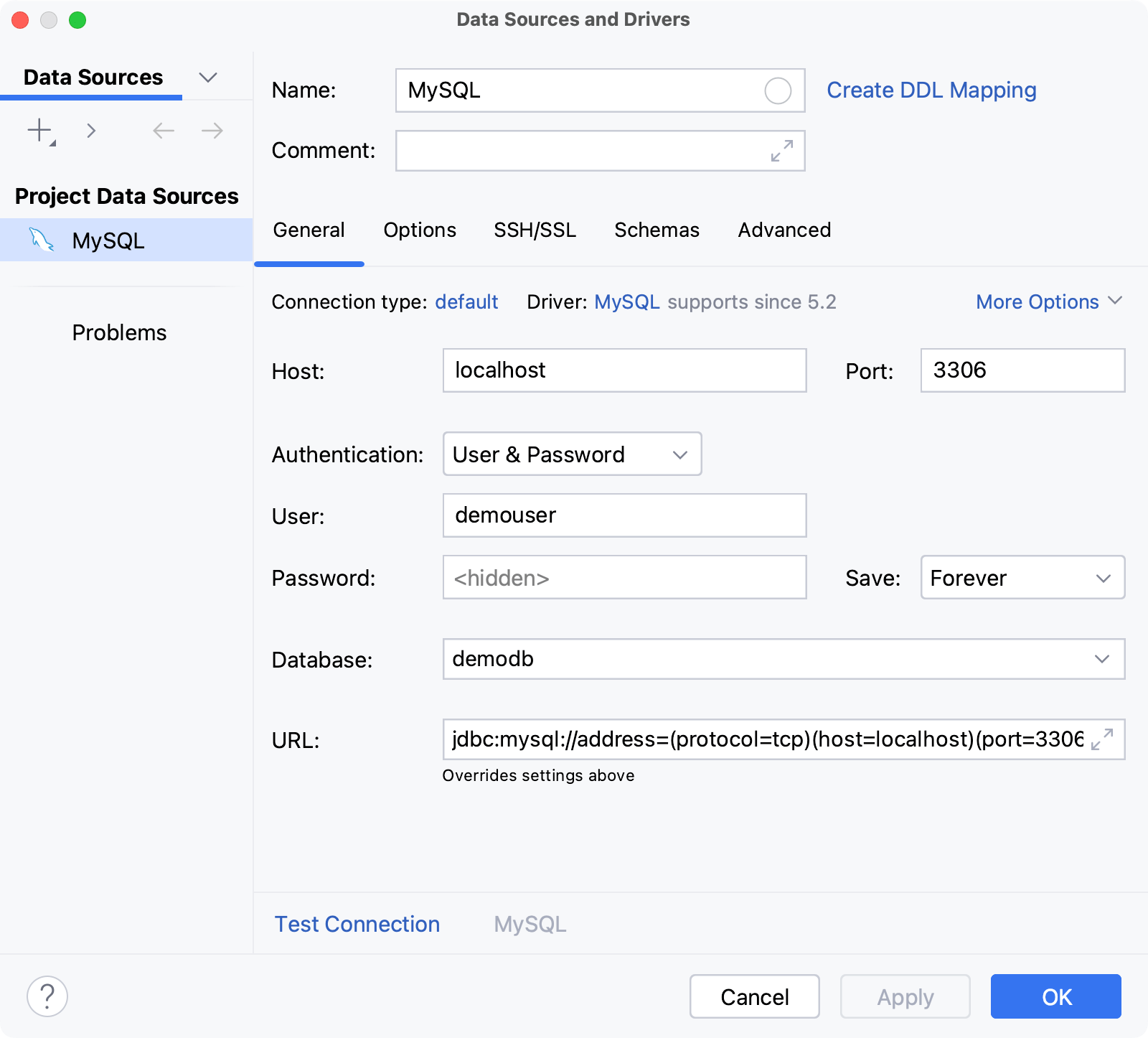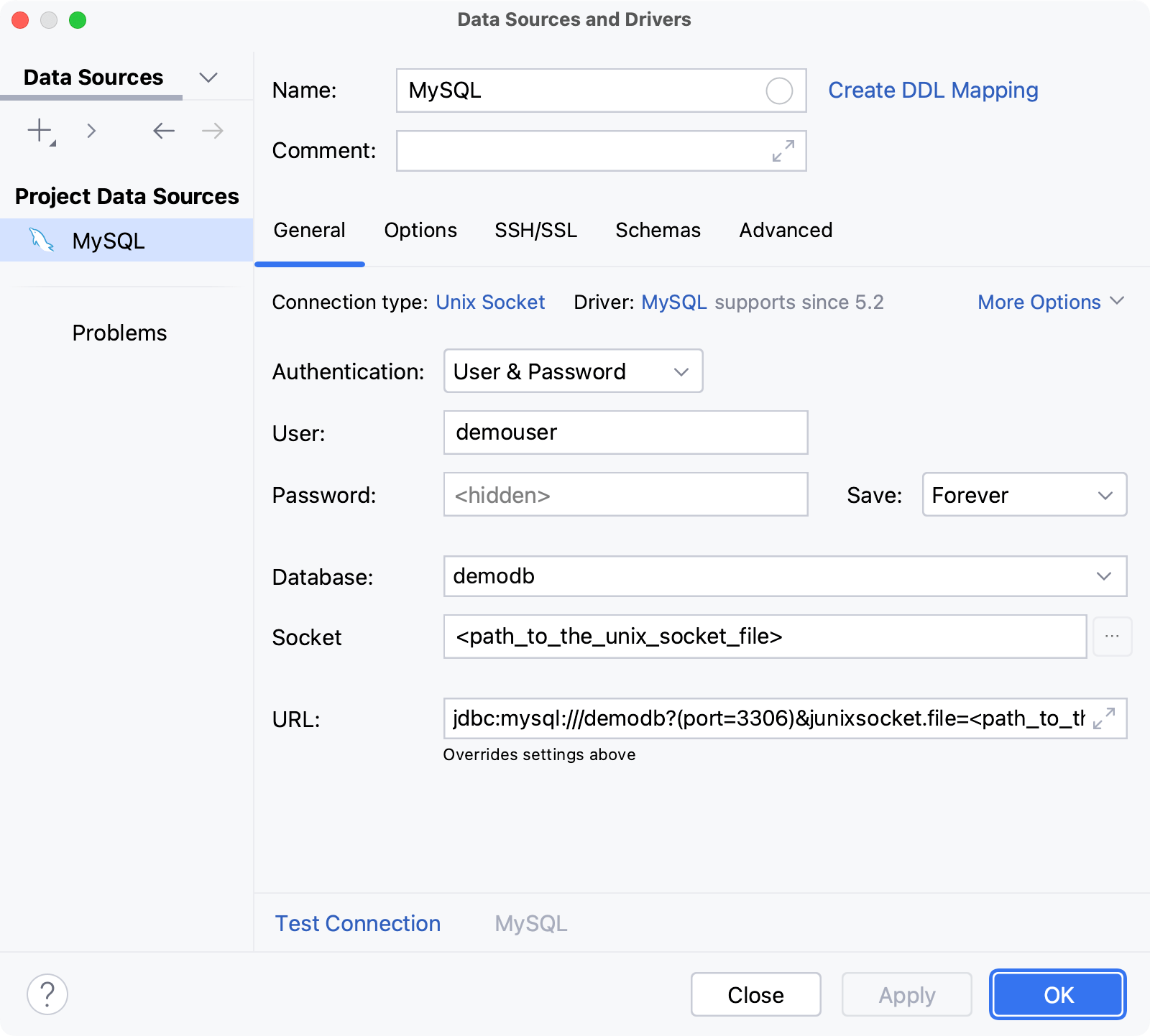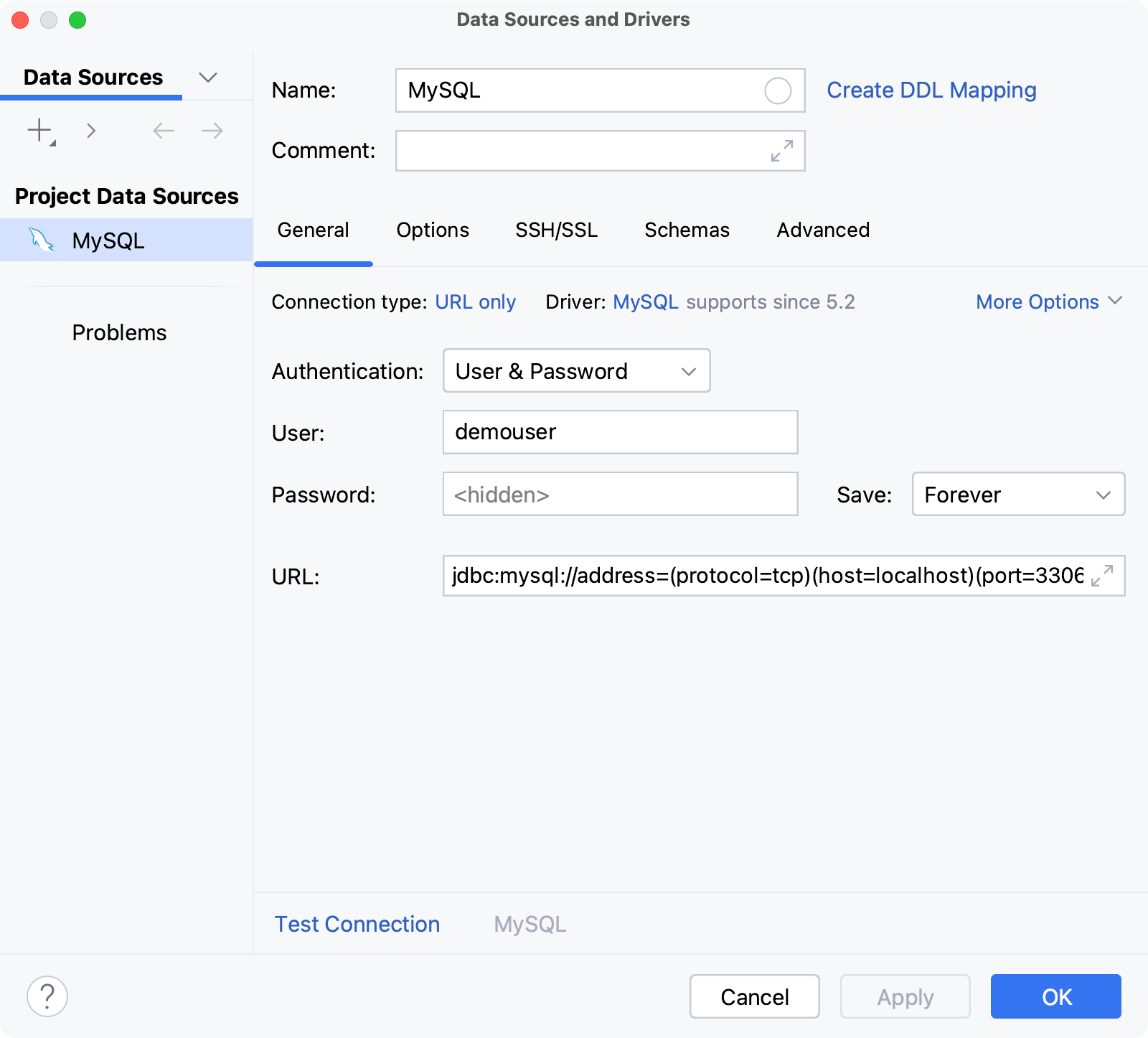MySQL
Official documentation and software
For full information about MySQL, refer to the official documentation.
To download MySQL database software, refer to the official software downloads.
Before you begin
This topic presents a general procedure on how you can create a data source for the connection to your MySQL database in DataGrip, and run a test connection. It is assumed that you already have the necessary connection details and the database is up and running.
For example, if you want to run a database on your machine and connect to that database, the corresponding DBMS software must be installed on the machine first.
To learn about your DBMS software, refer to its official documentation.
You can create MySQL data sources with named pipes and Unix sockets configuration. For more information about configuring these data sources, refer to Create a MySQL data source using named pipes and Create a MySQL data source using unix sockets.
Connect to a MySQL database
To connect to a database, create a data source that will store your connection details.
Select the data source you want to create. You can do this using one of the following ways:
In the main menu, go to and select MySQL.
In the Database Explorer (⌘ 1) , click
New on the toolbar. Navigate to Data Source and select MySQL.

In the General tab of Data Sources and Drivers dialog right pane, specify the driver and connection type.
In the Driver list, leave the default driver option, unless another driver is required for your connection.
From the Connection type list, select the connection type depending on the connection details that you have:
default: connect by using Host, Port, Database, and URL.
Unix Socket: connect by using a Unix socket file.
URL only: connect by using only the URL.
For the URL only connection type, the JDBC URL that you enter is used as is, including the database credentials.
For the other connection types, the JDBC URL is broken down into connection details. You can either specify them separately and use the automatically generated URL, or you can enter the URL directly in the corresponding field.

Check if there is a Download missing driver files link at the bottom of the connection settings area. Click this link to download drivers that are required to interact with a database. For a direct download link, refer to the JetBrains JDBC drivers page.

Location for the downloaded JDBC drivers is the DataGrip configuration directory.
You can also use your drivers for the database instead of the provided ones. For more information about connecting to a database with your driver, refer to Add a user driver to an existing connection.
If there is no Download missing driver files link, then you already have the required drivers.
Specify the database connection details. Alternatively, paste the JDBC URL in the URL field.
In the Host field, type your server address.
In the Port field, type the port of MySQL. The default port is 3306.
From the Authentication dropdown, select the authentication method that you want to use to authenticate the connection. The following options are available:
User & Password: by using your login and password.
No auth: authentication is not required.
In the User and Password fields, type your user credentials.
To use no password, leave the Password field empty.
To delete a once entered password, right-click the Password field and select Set Empty.

In the Database field, type the database name to which you want to connect.
In the URL field, DataGrip generates the JDBC URL automatically using the values of other connection settings.
If you need to use a JDBC URL with certain additional settings, paste it in the URL field. The general URL to use is as follows:
Format:
jdbc:mysql://address=(protocol=tcp)(host=<host_address>)(port=<port_number>)/<database_name>Example:
jdbc:mysql://address=(protocol=tcp)(host=127.0.0.1)(port=3306)/myDatabase
For more information about the URL format, refer to the MySQL official documentation.

From the Authentication dropdown, select the authentication method that you want to use to authenticate the connection. The following options are available:
User & Password: by using your login and password.
No auth: authentication is not required.
In the User and Password fields, type your user credentials.
To use no password, leave the Password field empty.
To delete a once entered password, right-click the Password field and select Set Empty.

In the Database field, type the database name to which you want to connect.
Enter the path to the Unix socket file in Socket. Alternatively, click the Open icon (
) and navigate to it.
URL only: connect by using only the URL.
In the URL field, DataGrip generates the JDBC URL automatically using the values of other connection settings.
If you need to use a JDBC URL with certain additional settings, paste it in the URL field. The general URL to use is as follows:
Format:
jdbc:mysql:///<database_name>?(port=3306)&junixsocket.file=<path_to_the_unix_socket_f&le>&socketFactory=org.newsclub.net.mysql.AFUNIXDatabaseSocketFactoryCJExample:
jdbc:mysql:///myDatabase?(port=3&06)&junixsocket.file=/var/run/s&ck/mdb.sock&socketFactory=org.newsclub.net.mysql.AFUNIXDatabaseSocketFactoryCJ
For more information about the URL format, refer to the MySQL official documentation.

From the Authentication dropdown, select the authentication method that you want to use to authenticate the connection. The following options are available:
User & Password: by using your login and password.
No auth: authentication is not required.
In the User and Password fields, type your user credentials.
To use no password, leave the Password field empty.
To delete a once entered password, right-click the Password field and select Set Empty.

In the URL field, DataGrip generates the JDBC URL automatically using the values of other connection settings.
If you need to use a JDBC URL with certain additional settings, paste it in the URL field.
For more information about the URL format, refer to the MySQL official documentation.

For the reference information about connection settings and properties on the General and other tabs of Data Sources and Drivers dialog (Ctrl+Alt+Shift+S) , see Connection settings and DBMS-specific properties.
Ensure that the database connection can be established using the provided details. To do this, click the Test Connection link at the bottom of the connection details section.

If you encounter any connection issues, refer to the Cannot connect to a database page.
(Optional) By default, only the default schema is introspected and available to work with. If you also want to work with other schemas, in the Schemas tab, select them for the introspection.

Click OK to create the data source.
Find your new data source in Database Explorer (⌘ 1) .
For more information about Database Explorer, see the corresponding reference topic.
For more information about working with database objects in DataGrip, refer to Database objects.
To write and run queries, open the default query console by clicking the data source and pressing F4.
To view and edit data of a database object, open Data editor and viewer by double-clicking the object.
Connection settings and DBMS-specific properties
Connection settings
For the reference information about connection settings (for example, Host, Port, and so on) on the General and other tabs of Data Sources and Drivers dialog (Ctrl+Alt+Shift+S) , see Data Sources.
DBMS-specific properties
General tab
Item | Description | Connection type |
|---|---|---|
Socket | The path to the Unix socket file. | Unix Socket |